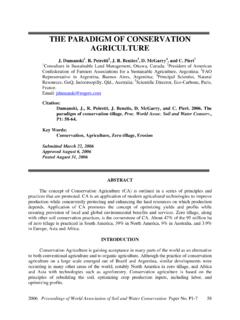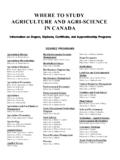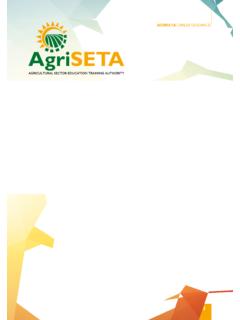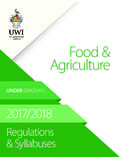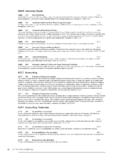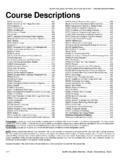Transcription of Types of Agriculture.sourced - unapcaem.org
1 Types of agriculture Agro-ecology Broadly stated, it is the study of the role of agriculture in the world. It is the study of the relation of agricultural crops and Agro-ecology provides an interdisciplinary framework with which to study the activity of agriculture . In this framework, agriculture does not exist as an isolated entity, but as part of an ecology of contexts. Agro-ecology draws upon basic ecological principles for its conceptual framework. Sustainable agriculture Sustainable agriculture refers to the ability of a farm to produce food indefinitely, without causing severe or irreversible damage to ecosystem Two key issues are biophysical (the long-term effects of various practices on soil properties and processes essential for crop productivity) and socio-economic (the long-term ability of farmers to obtain inputs and manage resources such as labor).
2 SA integrates three main goals: environmental stewardship, farm profitability, and prosperous farming communities. Urban agriculture / Peri-urban agriculture Urban agriculture is the practice of cultivating, processing and distributing food in, or around (peri-urban), a village, town or city3. Urban farming is generally practiced for income-earning or food-producing activities though in some communities the main impetus is recreation and relaxation. Urban agriculture contributes to food security and food safety in two ways: first, it increases the amount of food available to people living in cities, and, second, it allows fresh vegetables and fruits and meat products to be made available to urban consumers.
3 Organic agriculture Organic agriculture is a production system that sustains the health of soils, ecosystems and people4. It relies on ecological processes, biodiversity and cycles adapted to local conditions, rather than the use of inputs with adverse effects. Organic agriculture combines tradition, innovation and science to benefit the shared environment and promote fair relationships and a good quality of life for all involved. Conservation agriculture Conservation agriculture is a concept for resource-saving agricultural crop production that strives to achieve acceptable profits together with high and sustained production levels 1 Source: OECD glossary of statistical terms, Viewed March 2009 2 Source: UNCCD (2008).
4 , World Day to Combat Desertification 17 June 2008., Theme: Combating land degradation for sustainable agriculture ., Viewed March 2009 3 Bailkey, M. and J. Nasr. 2000. From Brownfields to Greenfields: Producing Food in North American Cities. Community Food Security News. Fall 1999/Winter 2000:6 4 Organic World Foundation (2008)., Making a Difference, Inspiring Action That is what Organic agriculture is. Viewed March 2009- while concurrently conserving the environment (FAO 2008)5. The first key principle in CA is practicing minimum mechanical soil disturbance which is essential to maintaining minerals within the soil, stopping erosion, and preventing water loss from occurring within the soil.
5 The second key principle in CA is much like the first principle in dealing with protecting the soil. The principle of managing the top soil to create a permanent organic soil cover can allow for growth of organisms within the soil structure. This growth will break down the mulch that is left on the soil surface. The breaking down of this mulch will produce a high organic matter level which will act as a fertilizer for the soil surface. The third and final principle that is exercised by the FAO is the practice of crop rotation with more than two crop species.
6 This process will not allow pests such as insects and weeds to be set into a rotation with specific crops. Rotational crops will act as a natural insecticide and herbicide against specific crops. Precision agriculture Precision Farming is a new technology that allows farmers to look at their fields more site specifically than before and apply inputs in a manner more specific than a blanket application. This technology saves money while holding or enhancing yield output of the field.
7 Environmental pollution is also be reduced using this method6. Precision agriculture uses ICT to cover the three aspects of production namely for data collection of information input through options as Global Positioning System (GPS) satellite data, grid soil sampling, yield monitoring, remote sensing, etc; for data analysis or processing through Geographic Information System (GIS) and decision technologies as process models, artificial intelligence systems, and expert systems; and for application of information by farmers.
8 Industrial agriculture Industrial agriculture is a form of modern farming that refers to the industrialized production of livestock, poultry, fish, and crops7. The methods of industrial agriculture are technoscientific, economic, and political. They include innovation in agricultural machinery and farming methods, genetic technology, techniques for achieving economies of scale in production, the creation of new markets for consumption, the application of patent protection to genetic information, and global trade.
9 These methods are widespread in developed nations and increasingly prevalent worldwide. Most of the meat, dairy, eggs, fruits, and vegetables available in supermarkets are produced using these methods of industrial agriculture . Bio-dynamic agriculture /ecological agriculture Biodynamic agriculture , a method of organic farming that has its basis in a spiritual world-view (anthroposophy, first propounded by Rudolf Steiner), treats farms as unified and individual organisms, emphasizing balancing the holistic development and interrelationship of the soil, plants, animals as a closed, self-nourishing system8.
10 Regarded by some proponents as the first modern ecological farming system, biodynamic farming includes organic agriculture 's emphasis on manures and composts and exclusion of the use of artificial chemicals on soil and plants. Methods unique to the biodynamic approach include the use of fermented herbal and mineral preparations as compost additives and field sprays 5 FAO 2008., agriculture and Consumer Protection Department, Conservation agriculture . What is Conservation agriculture ?
